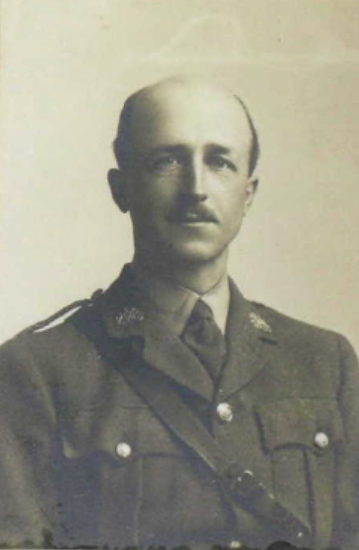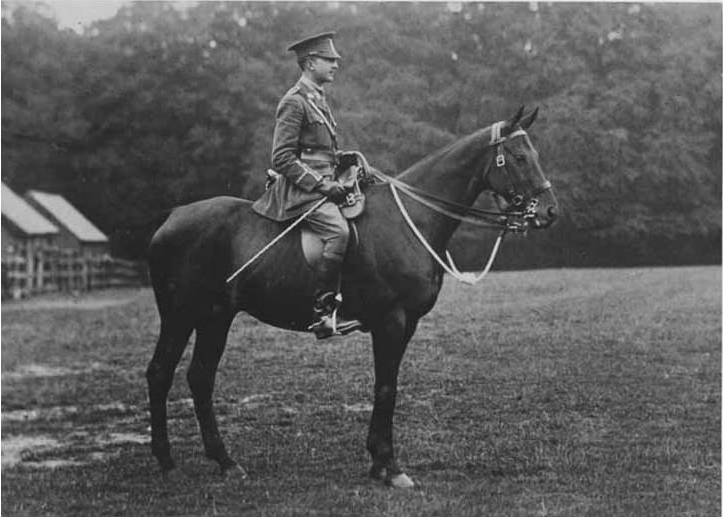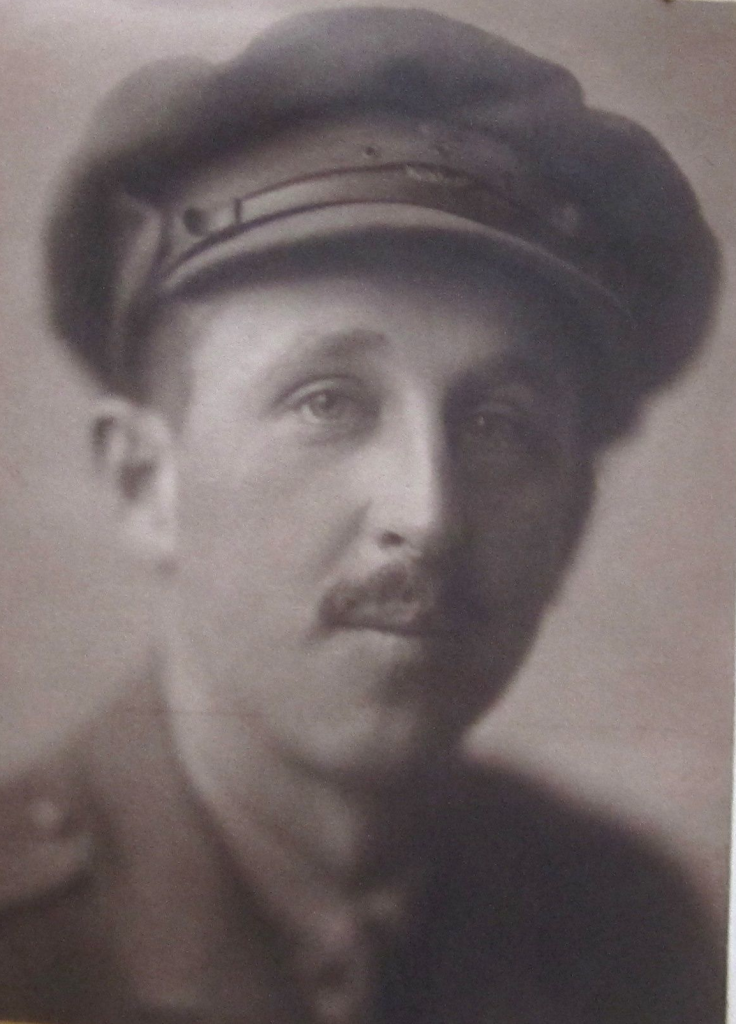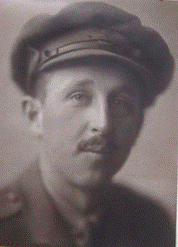Fact file:
Matriculated: 1901
Born: 6 June 1882
Death: 19 November 1916
Regiment: Shropshire Yeomanry attached to East Surrey Regiment
Grave/Memorial: Thiepval Memorial: Pier and Face 1A
Family background
b. 6 June 1882 in Clover Hill, Maryland, USA, as the elder son (two children) of Algernon Tillard (1847–87) and Mary Withers Florence Tillard (née Atkinson) (1859–1906) (m. 1881). Mary was later named Bonham-Carter after her second marriage, in 1891, to John Bonham-Carter (1852–1905). Mary Tillard and her sons were not in the UK at the time of the 1891 Census, but they may have been living in the USA. Unfortunately the data for the American Census of 1890 were largely destroyed in a fire in 1921. At the time of the 1901 Census Philip Algernon was studying with a private tutor in Scotland and in 1911 he was serving with the 2nd Battalion of the Royal Fusiliers in India.
Parents and antecedents
Tillard’s father was the fifth son of Phillip Tillard (1811–87) of Stukeley Hall, landowner, JP and Deputy Lieutenant of Huntingdonshire, and Phillippa Julia Baumgartner (1811–85). In 1871 Algernon Tillard was appointed a supernumerary Lieutenant in the Huntingdon Regiment of Rifle Militia (resigned 1876) and at the time of the Census that year he was staying with his uncle Edward Charrington (1811–88), landowner and brewer, at 28 Queen’s Gate, Kensington, who had married his mother’s sister, Georgiana Tryce Mary Baumgartner (1820–1911 ). After his father’s death in 1859 Edward Charrington and his brother Spencer ran the brewery, which in 1880 became Charrington and Co. (London and Burton-on-Trent). In April 1881 Algernon Tillard married the American Mary Withers Florence Atkinson and shortly after their marriage they sailed to New York on the SS Bothnia. He was registered as a farmer and immigrant. He bought Clover Hill, near Frederick in Carroll County, Maryland, in 1881 with the aim of creating an English estate. We do not know how much he paid for it but his predecessor bought it ten years before for $29,000. He made improvements and in 1886 the house was described thus “The mansion is surrounded with stately shade trees. It has a handsome portico in front, and a wide verandah extending the whole length of the back building.” He died the following year of heart and liver trouble. At his death the estate had a flock of 113 ewes (Shropshiredown), 15 milking cows and 30 other cattle, two horses, four mules and six hogs. Clover Hill was sold in 1888 to the son of a governor of Maryland. Algernon’s widow and children returned to England but in 1889 Mary Tillard, with her older sister Louisa Atkinson, sailed to New York on the SS Etruria with her sons Philip and Thomas, whose place of birth was given as England although they were born in the USA.
Tillard’s maternal grandmother was the daughter of John Thomas Baumgartner (1778–1874) of Huguenot Swiss extraction, an MD of Edinburgh University, of Island Hall, Godmanchester, where he practised medicine.
Tillard’s mother was the daughter of Thomas Withers Atkinson (1828–72) a merchant of Baltimore, and Maria Luis Dell (1830–74); and she was the great-niece of Dr Thomas Atkinson (1807–81), bishop of North Carolina. Her second husband was the son of John Bonham-Carter (1817–84), the Liberal MP for Winchester from 1847 to 1874, and the grandson of John Bonham-Carter (1788–38), the MP for Portsmouth from 1816 to 1838. She was given away by her brother-in-law Philip Edward Tillard; and her two sons, Philip Algernon and Thomas, were pages. Philip Edward Tillard had married John Bonham-Carter’s sister Iona Mary Bonham-Carter (1850–1936), and at the time of the 1891 Census he and his family were visiting his brother-in-law at Adhurst St Mary (12 servants). Another visitor was Horace Darwin (1851–1928), the fifth son of Charles Darwin. John Bonham-Carter was found dead from a bullet wound to the head in a wood on his estate on 21 December 1905. An inquest was held in the gun-room of Adhurst St Mary on 23 December and the jury returned a verdict of “suicide while in a state of unsound mind”. Two contributing factors to his condition were head injuries due to falling off a horse and the severe and prolonged illness of his wife, who survived him by just two weeks, dying at Adhurst St Mary on 5 January 1906.
Tillard was related by marriage to Guy Bonham-Carter (1884–1915).
Siblings and their families
Tillard’s brother, Thomas Atkinson Tillard (1884–1916), was killed in action on 6 December 1916 while serving in France as a Lieutenant (pilot) with the Royal Flying Corps (RFC).
Tillard also had a half-sister, Helen Mary Bonham-Carter (1896–1987), the daughter of Mary Tillard and John Bonham-Carter. Her later name was Lubbock after her marriage in 1918 to Alan (later Sir Alan) Lubbock (1897–1990); two sons.
Thomas Atkinson studied for an Ordinary Degree (with a special paper on Mechanism and Applied Sciences) at Trinity College, Cambridge (1902–05). He also studied at Massachusetts Institute of Technology and was in the class of 1909. He was commissioned in the Norfolk Yeomanry in October 1914. But he learnt to fly, and received his aviator’s certificate at the Military School, Norwich, on 25 January 1916 flying a Morris Farman Biplane. He became an officer in the RFC in March 1916, was wounded on 6 July 1916 and was killed in action on 6 December 1916, a few weeks after his elder brother. He is buried in the Bailleul Cemetery Extension (Nord), Grave III.A.207.
Sir Alan Lubbock was the youngest son of the banker Frederic Lubbock (1844–1927) and one of the brothers of the writer and critic Percy Lubbock (1879–1965). During the war he served in France with the Royal Garrison Artillery, and after the war he was a Fellow of King’s College Cambridge from 1922–28. He was elected an Independent county councillor for the Petersfield Division of Hampshire in 1932, becoming chairman of the council and Pro-Vice Chancellor of Southampton University. He was interested in education and served on the Burnham Committee and the National Foundation for Educational Research. He was knighted in 1963.
Wife
In 1914 Tillard married Augusta Muriel Hay Murray (1882–1951), whose later name was Wolryche-Whitmore after her marriage in 1919 to Captain Geoffrey Charlton Wolryche-Whitmore, JP (1881–1969), Quatt, Bridgnorth, Shropshire, Tillard’s contemporary at Magdalen. She was the daughter of Robert Evelyn Hay Murray (1851–1910), Private Secretary to Lord Rosebery (1847–1929) during his premiership (March 1894–June 1895). In 1918, i.e. before her second marriage, Tillard’s widow was living at 34, Hill Street, Knightsbridge, London SW1, a fashionable district of Mayfair, and she seems to have moved from there to nearby Mill Cottage, Park Row, Knightsbridge.
Geoffrey Charlton Wolryche-Whitmore, of Dudmaston Hall, Quatt, was a widower and a Shropshire landowner with a special interest in forestry. His first wife (m. 1907) was Susan Lethbridge (1881–1907). Like Tillard, he had been an undergraduate at Magdalen (1901–04) and had read for a pass degree in legal subjects with a special emphasis on contracts. After taking his BA in 1904, he stayed on for an extra year at Magdalen to be the President of its Junior Common Room. He became Mayor of Bridgnorth in 1914 and during the war served as a Captain in the Shropshire Yeomanry – but on home duties. He also served as a Lieutenant in the 3rd (Reserve) Battalion of the Shropshire Light Infantry. From 1928 to 1935 he was Joint Master of Wheatland Foxhounds and from 1944 to 1936 he was the President of the Royal English Forestry Society.
Education and professional life
From 1892 to 1895 Tillard attended Horris Hill Preparatory School (also known as Mr Evans’s Preparatory School), Hampshire (founded 1888; cf. M.K. Mackenzie, G. Bonham-Carter, G.H. Alington, R.H. Hine-Haycock, H.F. Yeatman), and then, from 1895 to 1900, nearby Winchester College, where he is remembered for his prowess at golf. He spent much of 1900–01 with a private tutor at Bourtree Brae, Lower Largo, Fife, Scotland, on the northern shore of the Firth of Forth, and matriculated at Magdalen as a Commoner on 14 October 1901, having taken Responsions in Hilary Term 1901. He took the First Public Examination in Trinity Term 1902 and October 1902, and then read for a Pass Degree during the four terms from Trinity Term 1903 to Trinity Term 1904 (Groups B1 [English], B2 [French Language], and C1 [The Elements of Algebra and Geometric Trigonometry]). He took his BA on 20 October 1904. During his time at Magdalen he played a lot of golf. When war broke out he was acting as land-agent to Noel Wills, Cirencester.
Military and war service
Tillard was 6 foot tall and originally intended to become a career officer in the Regular Army. So after leaving Oxford, where he had held a Commission as Second Lieutenant in the 1st (Oxford University) Volunteer Battalion, the Oxfordshire Light Infantry (London Gazette, no. 27770, 3 March 1905, p. 1,582), he went on an officer training course at the Territorial Army’s main school of instruction, in Chelsea Barracks, London, from 1 to 29 April 1905. In September 1905 he sat the examination for obtaining a Commission in the Regular Forces as a University Candidate – but failed it. Nevertheless, on 29 November 1905 Tillard’s Territorial Commission as Second Lieutenant was transferred from the 1st (Oxford University) Volunteer Battalion, the Oxfordshire Light Infantry, to the 1st (Regular) (City of London) Battalion (Royal Fusiliers), the London Regiment (London Gazette, no. 27,858, 28 November 1905, p. 8,538). By 26 June 1906, while serving with the 1st Battalion, Tillard was in hospital in Portsmouth suffering from inflammation of the left knee, the legacy of an injury incurred while playing hockey, and this condition prevented him from walking and caused him to be given three months’ medical leave of absence – until 27 September 1906 – much of which he spent in the military hospital at Portsmouth. At some point after that, he was transferred to the 2nd (Regular) (City of London) Battalion of the same Regiment, which was currently serving in India, where Tillard joined it, and the 1911 Census records him as a Lieutenant with the Battalion in India. He was promoted Lieutenant, but after arriving back in England on leave as from 8 January 1912, he resigned his Commission on 20 January 1912, explaining that he wished to go into civil employment.
Nevertheless, on 9 January 1913 he applied for a Territorial Force commission in the 1/1st Shropshire Yeomanry, part of the Welsh Border Mounted Brigade, was gazetted 2nd Lieutenant (London Gazette, no. 28,703, 21 March 1913, p. 2,160), and served with them until he was mobilized on the outbreak of war. On 13 March 1915 he was made up to Acting Captain and then attached to the East Surrey Regiment, probably its 6th (Territorial Force) Battalion, on 5 October 1915. Tillard did not arrive in France until 12 August 1916 and seems to have been transferred to the 8th (Service) Battalion of the East Surrey Regiment, which had landed at Boulogne on 28 July 1915 and which stayed in France for the rest of the war as part of 55th Brigade, 18th (Eastern) Division.
The Battalion War Diary of the 8th Battalion rarely mentions names, even those of officers, and it records neither Tillard’s arrival nor his death. But the Battalion suffered heavy casualties during the first phase of the Battle of the Somme (1–4 and 13/14 July), and after re-equipping and extensive training in northern France, east of Armentières, it returned to the Somme in mid-September. Here it trained at Puchevillers, c.11 miles west of Albert, from 11 to 23 September, and on 28 September it moved to Blighty Valley, just north of Albert near Aveluy, and South Bluff. On 29/30 September 1916, the Battalion suffered more heavy casualties both before and during its assault on the east face of the Schwaben Redoubt, to the north of nearby Thiepval. One of these was Oliver Francis Madox Hueffer (1876–1931), the brother of the writer Ford Madox Ford (1873–1939), who is best remembered for his war novel The Good Soldier (1915); another was the Battalion’s Medical Officer, Owen Guy Parry-Jones. The Battalion was relieved on 1 October 1916 and returned to Blighty Valley until 5 October. But on 6 October it marched about four miles westwards to the little town of Acheux-en-Amiénois before being taken by train to Candas, some four miles south-west of Doellens. It rested and re-formed here until 15 October and then returned on foot to Albert, near the front line, where it continued training and re-forming from 18 to 26 October.
As Tillard was confirmed in the rank of Captain on 31 October 1916 (London Gazette, no. 29,902, 13 January 1917, p. 566), he probably joined the 8th Battalion as a replacement Company Commander at some point during October 1916, i.e. a few weeks after Parry-Jones’s death. The Battalion then spent the period from 26 to 31 October in trenches near Albert, almost certainly those south of Grandcourt, a village on the River Ancre. From 1 to 4 November it trained at Warloy-Baillon, about five miles west of Albert, and it returned to the front-line trenches on 4 November, where it would take part in the two final days of the Battle of the Ancre (13–19 November). The 11th (Canadian) Infantry Brigade, in which T.B. Cave was serving as a non-commissioned officer, was positioned immediately to the left of Tillard’s 55th Brigade, so the two men must have been within 1,000 yards of one another when Cave was killed in action during the fighting that took place in the small hours of 12 November. On 18 November, 55th Brigade, including Tillard’s Battalion, were positioned in Regina Trench about 1,000 yards south of the village of Grandcourt, on the south bank of the River Ancre. At 08.00 hours the Brigade advanced northwards, took Desire Trench to the south-west of Grandcourt by 08.10 hours, consolidated its position there, and then pressed on to Grandcourt Trench, the next trench to the north, which was captured by the night of 19 November but could not be held.
Although the circumstances surrounding Tillard’s death during this action have not been recorded, he was probably killed in action, aged 34, by a sniper, while leading his men across no-man’s-land south of Grandcourt during the morning of 19 November 1916, since the Battalion War Diary says that 18/19 November was marked by much sniper activity. Although his body was found some days later and buried, he now has no known grave. He is commemorated on Pier and Face 1A, Thiepval Memorial, and on the War Memorial at Miserden Church, Gloucestershire. He left £200 (c.£18,000 in 2005) to the Polo Club of the 2nd Battalion, the Royal Fusiliers, for the purchase of polo ponies.
Bibliography
For the books and archives referred to here in short form, refer to the Slow Dusk Bibliography and Archival Sources.
Printed sources:
[Anon.], ‘The Death of Mr. John Bonham Carter. Inquest and Verdict’, Hampshire Chronicle, no. 7,128 (30 December 1905), p. 10.
Rendall, i (1921), p. 198 (photo).
Leinster-Mackay (1984), pp. 107, 113, 139.
[Anon.], Sir Alan Lubbock [Obituary], The Times, no. 63,677 (11 April 1990), p. 14.
McCarthy (1998), pp. 123–5, 150–1 and 159–60.
United States Department of the Interior, National Parks Service, National Register of Historic Places Registration Form, Property Cold Saturday aka Clover Hill (also online at: https://mht.maryland.gov/secure/medusa/PDF/Carroll/CARR-29.pdf, accessed 19 July 2019).
Archival sources;
MCA: Ms. 876 (III), vol. 3.
OUA: UR 2/1/46.
WO95/2046.
WO95/2050.
WO95/4427.
WO374/68826.
On-line sources:
Wikipedia: ‘Hill Street Mayfair’: https://en.wikipedia.org/wiki/Hill_Street,_London (accessed 19 July 2019).



